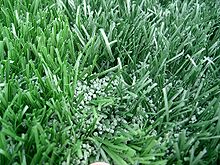
Back عشب صناعي Arabic Штучная трава Byelorussian Gespa artificial Catalan Umělý trávník Czech Юрилле курăк CV Kunstgræs Danish Kunstrasen German Τεχνητός χλοοτάπητας (ποδόσφαιρο) Greek Césped artificial Spanish Kunstmuru Estonian
This article needs additional citations for verification. (May 2024) |




Artificial turf is a surface of synthetic fibers made to look like natural grass, used in sports arenas, residential lawns and commercial applications that traditionally use grass. It is much more durable than grass and easily maintained without irrigation or trimming, although periodic cleaning is required. Stadiums that are substantially covered and/or at high latitudes often use artificial turf, as they typically lack enough sunlight for photosynthesis and substitutes for solar radiation are prohibitively expensive and energy-intensive. Disadvantages include increased risk of injury especially when used in athletic competition, as well as health and environmental concerns about the petroleum and toxic chemicals used in its manufacture.
Artificial turf first gained substantial attention in 1966, when ChemGrass was installed in the year-old Astrodome, developed by Monsanto and rebranded as AstroTurf, now a generic trademark (registered to a new owner) for any artificial turf.
The first-generation system of shortpile fibers without infill of the 1960s has largely been replaced by two more. The second features longer fibers and sand infill and the third adds recycled crumb rubber to the sand. Compared to earlier systems, modern artificial turf more closely resembles grass in appearance and is also considered safer for athletic competition. However, it is still not widely considered to be equal to grass. Sports clubs, leagues, unions and individual athletes have frequently spoken out and campaigned against it, while local governments have enacted and enforced laws restricting and/or banning its use.